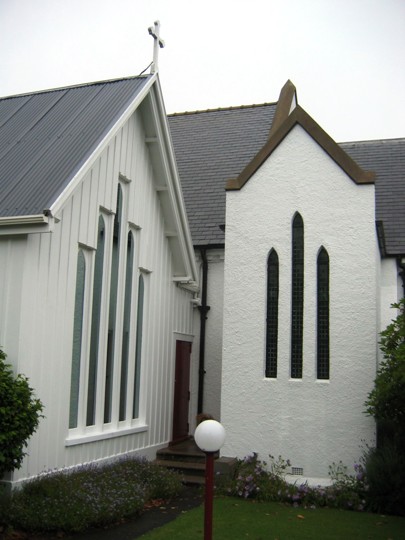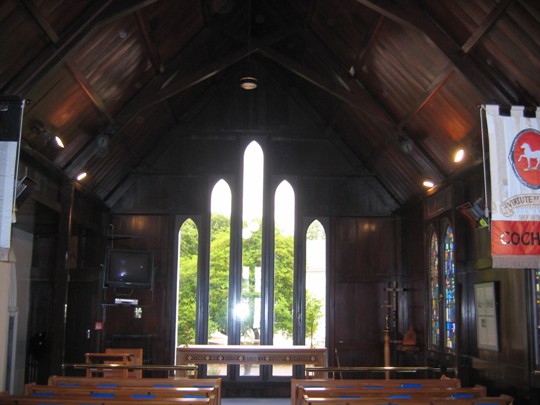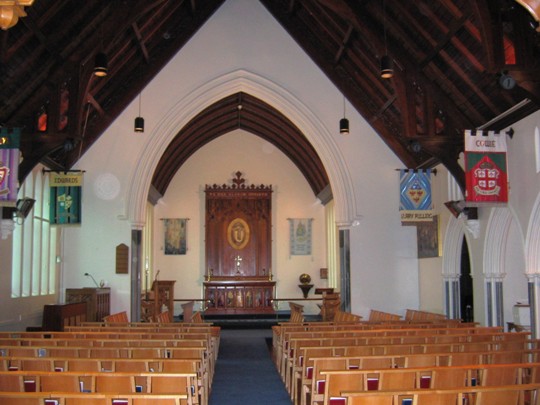St Barnabas' Chapel and Bishopscourt, Parnell Built between 1863 and 1866, St Barnabas' Chapel was originally erected as Bishop Selwyn's private chapel at Bishopscourt in Parnell, but was moved to the Diocesan High School for Girls in 1910. Bishopscourt (now known as Selwyn Court) was constructed as a permanent residence for the Anglican Bishop, George Selwyn (1809-1878) and his successors. The complex, which included a house, library, baptistry and bell tower as well as the chapel, was designed by architect Frederick Thatcher under the direction of Bishop Selwyn. It was built in a form of Gothic Revival style later known as 'Selwyn Gothic', which is considered the first attempt to develop a vernacular architectural style in colonial New Zealand. Bishop Selwyn arrived in New Zealand in 1842 with the responsibility of overseeing the formation of the Anglican Church in New Zealand. His major achievement was the creation of the Constitution of the Church of the Province of New Zealand, but part of his task was also to oversee the erection of substantial church buildings. Selwyn moved to Auckland in 1844 where he began to commission works in the Gothic Revival style, beginning with St John's College at Tamaki. The style was heavily influenced by the ideals of the Camden Society (later known as the Ecclesiological Society), of which Selwyn was a member. On his consecration as Bishop of New Zealand, Selwyn was also made a patron of the Society. Based in England, the Society aimed to revive medieval forms of architecture as a reaction to the perceived 'decadence' of Georgian church architecture. The Society's beliefs can be seen as part of a conservative response to widespread social discontent in Britain at the time. The preferred architectural style of the Camden Society was fourteenth-century Gothic, which emphasised the roots of the Anglican faith in medieval High Church worship. Other features considered important were a steeply pitched roof, a raised chancel and a simple functional interior, which included exposed internal beams. Many of these features were translated into the Selwyn Gothic Style, whose major point of difference from Gothic Revival buildings in Britain was the use of timber rather than stone. Bishopscourt was built between 1863 and 1866 and has been described as 'the most ambitious secular building of the Selwyn series.' Architectural historian, John Stacpoole, describes the style of the complex: 'Bishopscourt, or Selwyn Court as it is known today, is a most remarkable piece of planning. Thatcher's felicities of ingeniously controlled roofs, introduced gables, and windows based mainly on multiplications of the lancet form relieved by an occasional trefoil or quatrefoil, were by this time to be expected. At Selwyn Court he made full use of roofs of broken pitch - roofs which flatten out towards the eaves - and he also introduced generously-dimensioned casement windows to the north-facing living rooms.' The chapel was an integral part of Bishopscourt, being centrally positioned in the complex. It was erected between the study and the office, protruding at right angles to the main building. The back of the church served as a corridor between these spaces, while the main body of the chapel was screened. Its architect, the Reverend Frederick Thatcher (1814-1890), was a designer of note, whose masterpiece is considered to be Old St Paul's in Wellington. Like Selwyn, he was a vigorous proponent of what was termed 'colonial Gothic'. St Barnabas' Chapel exemplified the Selwyn Gothic style of architecture, in particular its steeply pitched roof, vertical cladding, exposed structural members, latticed glass panels and rose window. The sparse furnishings and dark brown interior were also typical of this style. The building is considered to have been built by Alexander Hunter. Following its construction, Bishopscourt became the centre of Diocesan work and many special services were held in the chapel from 1864-1910 during the occupancy of Bishops Selwyn, Cowie and Neligan. The first baptism was held on 29 June 1865, when the son of Captain Betty of the Royal Artillery was baptised. The first marriage in the chapel occurred in 1866. The chapel also has connections with Bishop J.C. Patteson (1827-1871), the first Bishop of Melanesia who was martyred in 1871. Patteson was a close associate of Selwyn who stayed at Bishopscourt when his mission boat, the Southern Cross, was in Auckland. By 1900, there were serious problems with dampness at Bishopscourt and in 1908 a new brick residence was erected alongside the old timber buildings. In 1910 the Synod announced the decision to move St Barnabas' Chapel to Diocesan School, so that it 'might be used for such purposes as were in conformity with the past use of the Building'. Previous modifications to the chapel had included boarding up some of the lancet windows in the eastern wall of the structure. This had occurred prior to 1891. St Barnabas' Chapel and the Diocesan School for Girls The Diocesan High School for Girls was established by Bishop Neligan in June 1903 as an Anglican educational institution. It initially evolved under the guidance of Mary Pulling (1871-1951), the school's first headmistress, who had taught in some of Britain's premier private colleges. Pulling aimed to provide standards that equalled the best of those of the state sector, while promoting education of a religious nature. She went on to play a prominent role in raising the professional standards of church schools throughout New Zealand. The institution was established on land previously known as St John's Wood, which had been owned by Edwin Hesketh, a wealthy lawyer and active member of the Anglican Church. Hesketh and his family had occupied a large Italianate residence on the site, surrounded by substantial grounds. The school opened in 1904 with a roll of 25 pupils. It contained two classrooms, housed in the converted residence (now known as School House). As an Anglican school, religious services formed an important part of school life. These were initially held in an upstairs room of the main residence that had been set aside as a chapel. The relocation of St Barnabas' Chapel in 1910 not only provided a more suitable religious setting for such services, but also reflected Pulling's aim to create an institution that drew from a specifically New Zealand Anglican inheritance. Pulling herself lived at Bishopscourt throughout her tenure as headmistress, and was particularly interested in design and architecture. She also put on historical pageants at the school, including one based on the life of Bishop Patteson, with whom the building had links. For more than a decade, the building was the main focus of the school's religious life. The Chapel was positioned a short distance from the main school building, close to the former site of Edwin Hesketh's stables and laundry. From the outset, it was only just large enough to accommodate the school, but Pulling believed its smallness was more than compensated for by its architectural merits and historical associations. The first service on the new site was held on St Barnabas' Day on 11 June 1910. A porch on the south west of the building appears to have been added shortly after its relocation. The chapel, however, quickly became too small to accommodate all school members. A new structure, the Chapel of Our Glorified Lord, was built in 1922 against the western side of St Barnabas'. The western wall of the chapel had previously held a pair of lancet windows towards its northern end, mirroring the windows on the eastern side of the chapel. The new chapel retained the east and south walls of the porch, while the western wall of St Barnabas' was replaced by an open arcade, allowing a visual connection between the two spaces. Sometime after the mid 1980s, two pairs of lancet windows were added to the eastern side of the chapel (in the middle and south end of the wall) and all three pairs of lancet windows were fitted with stained glass. A decade later, parts of the lancet windows in the eastern wall boarded up prior to 1891 were uncovered. In some respects this was a compromise. The pointed arches installed by Mrs Cowie were retained and a similar treatment was given to the outer windows. Plate glass was installed right down to the floor and the Selwyn lattice was not reinstated. Today, the chapel remains in use as part of the larger place of worship. Various houses take turns at having Sunday services there and wedding services are also held for old girls.



Location
List Entry Information
Overview
Detailed List Entry
Status
Listed
List Entry Status
Historic Place Category 2
Access
Private/No Public Access
List Number
2646
Date Entered
6th June 2005
Date of Effect
6th June 2005
City/District Council
Auckland Council
Region
Auckland Council
Extent of List Entry
The registration includes part of the of the land in RT NA763/288 (as shown on Map C in Appendix 4) and the buidling, its fittings and fixtures, thereon. The area of registration extends one metre beyond the outer walls of the chapel on its northern, eastern and southern sides.
Legal description
Part of Allot 11 Sec 11 Suburbs of Auckland (RT NA763/288)
Stay up to date with Heritage this month
